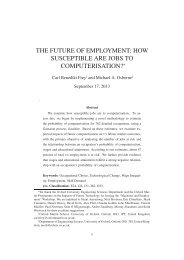THE FUTURE OF EMPLOYMENT: HOW SUSCEPTIBLE ARE JOBS TO COMPUTERIZATION?
We examine how susceptible jobs are to computerization. To assess this, we begin by implementing a novel methodology to estimate the probability of computerization for 702 detailed occupations, using a Gaussian process classifier. Based on these estimates, we examine expected impacts of future computerization on US labor market outcomes, with the primary objective of analyzing the number of jobs at risk and the relationship between an occupation’s probability of computerization, wages and educational attainment. According to our estimates, about 47 percent of total US employment is at risk. We further provide evidence that wages and educational attainment exhibit a strong negative relationship with an occupation’s probability of computerization.
We examine how susceptible jobs are to computerization. To assess this, we begin by implementing a novel methodology to estimate the probability of computerization for 702 detailed occupations, using a Gaussian process classifier. Based on these estimates, we examine expected impacts of future computerization on US labor market outcomes, with the primary objective of analyzing the number of jobs at risk and the relationship between an occupation’s probability of computerization, wages and educational attainment. According to our estimates, about 47 percent of total US employment is at risk. We further provide evidence that wages and educational attainment exhibit a strong negative relationship with an occupation’s probability of computerization.
Create successful ePaper yourself
Turn your PDF publications into a flip-book with our unique Google optimized e-Paper software.
substitution will be confined to routine tasks, our model predicts that computerisation<br />
can be extended to any non-routine task that is not subject to any engineering<br />
bottlenecks to computerisation. These bottlenecks thus set the boundaries<br />
for the computerisation of non-routine tasks. Drawing upon the ML and<br />
MR literature, and a workshop held at the Oxford University Engineering Sciences<br />
Department, we identify several engineering bottlenecks, corresponding<br />
to three task categories. According to these findings, non-susceptible labor inputs<br />
can be described as,<br />
(2) L NS =<br />
n∑ ( )<br />
LPM,i +L C,i +L SI,i<br />
i=1<br />
where L PM , L C and L SI are labour inputs into perception and manipulation<br />
tasks, creative intelligence tasks, and and social intelligence tasks.<br />
We note that some related engineering bottlenecks can be partially alleviated<br />
by the simplification of tasks. One generic way of achieving this is to reduce<br />
the variation between task iterations. As a prototypical example, consider<br />
the factory assembly line, turning the non-routine tasks of the artisan shop into<br />
repetitive routine tasks performed by unskilled factory workers. A more recent<br />
example is the computerisation of non-routine manual tasks in construction.<br />
On-site construction tasks typically demand a high degree of adaptability, so<br />
as to accommodate work environments that are typically irregularly laid out,<br />
and vary according to weather. Prefabrication, in which the construction object<br />
is partially assembled in a factory before being transported to the construction<br />
site, provides a way of largely removing the requirement for adaptability. It allows<br />
many construction tasks to be performed by robots under controlled conditions<br />
that eliminate task variability – a method that is becoming increasingly<br />
widespread, particularly in Japan (Barlow and Ozaki, 2005; Linner and Bock,<br />
2012). The extent of computerisation in the twenty-first century will thus partly<br />
depend on innovative approaches to task restructuring. In the remainder of this<br />
section we examine the engineering bottlenecks related to the above mentioned<br />
task categories, each in turn.<br />
Perception and manipulation tasks. Robots are still unable to match the<br />
depth and breadth of human perception. While basic geometric identification is<br />
24





